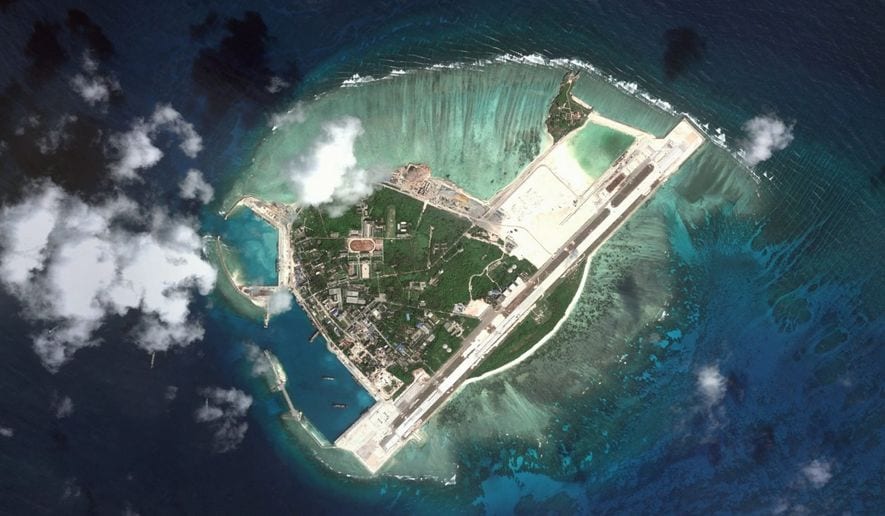The confrontation between U.S. and Chinese warships in the South China Sea brings Freedom of Navigation operations back to the forefront of U.S. international relations.
Tensions between the United States and the People’s Republic of China increased on September 30, when the Chinese People’s Liberation Army Navy vessel Lanzhou (DDG 170), a Type 052C Luyang II-class destroyer, nearly collided with American destroyer U.S.S. Decatur (DDG 73) in the South China Sea.
The American Arleigh-Burke Class destroyer came into contact with the Chinese vessel as it sailed past Gaven Reef, part of the Spratly Islands. The People’s Liberation Army claims the Spratly Islands, where it is constructing airfields and naval bases on artificial land.
Following this close shave, a U.S. defense official speaking to Fox News asserted that the Navy was conducting a routine “freedom of navigation” operation in order to “uphold the rights and freedoms of all states under international law.”
In an Oct. 4 speech at the Hudson Institute, Vice President Mike Pence acknowledged the Decatur’s mission parameters and reaffirmed the U.S. policy of conducting freedom-of-navigation operations in the South China Sea. Calling the Chinese ship’s behavior “reckless harassment” Pence said that “the United States Navy will continue to fly, sail, and operate wherever international law allows and our national interests demand.”
FONOPS in the Regular Course
Freedom-of-navigation operations, or FONOPS, are not new in the U.S. Navy playbook. According to Gregory Poling, director of the Asia Maritime Transparency Initiative and Southeast Asia Program and a fellow at the Southeast Asia Program at the Center for Strategic and International Studies, FONOPS conducted by the Trump administration are “fundamentally the same policy tool wielded by the Obama administration, and indeed by every U.S. administration since [Jimmy] Carter.”
According to an Oct. 9 article in maritime analysis publication The Maritime Executive, a recent U.S. Department of Defense report noted that the Navy had conducted FONOPS against 22 nations since January.

The U.S.’s freedom-of-navigation exercises take their legitimacy from the United Nations Convention on the Law of the Sea (UNCLOS). The 1994 UNCLOS treaty sets the framework for how states can define their sovereign territory at sea.
A report from the Belfer Center for Science and International Affairs & the Harvard Kennedy School describes how these ground rules are blurred in the South China Sea. According to the report, UNCLOS dictates that shorelines and islands, in addition to a 12-nautical-mile “territorial sea” zone, also have a 200-nautical-mile “Exclusive Economic Zone” in which a state can utilize natural resources or conduct other economic activity. Other maritime formations, the Belfer report says, only have a territorial sea zone of 12 nautical miles and no Exclusive Economic Zone.
In the South China Sea, the People’s Republic of China is building islands on top of reefs and low-tide elevations. According to UNCLOS, these islands constitute only a territorial sea zone, with no Exclusive Economic Zone, as the natural formations underneath them do not qualify as islands.
We will not be intimidated and we will not stand down.
-Vice President Mike Pence
The U.S. Navy conducts FONOPS to signal to Beijing that Washington doesn’t recognize the legitimacy of the South China Sea’s artificial islands under UNCLOS. The Chinese government challenged the American rationale for the near collision. In an Oct. 2 statement reported in the South China Morning Post, the Chinese Ministry of Defense said that “The Chinese vessel took quick action and made checks against the US vessel in accordance with the law, and warned it to leave the waters.”
The Post also reported that Chinese foreign ministry spokeswoman Hua Chunying called U.S. FONOPS “wrong behaviour.” She called on Washington to “stop the provocations to avoid damaging China-US relations and regional peace and stability.”
Vice President Pence was firm on the U.S. policy towards freedom-of-navigation operations in his Oct. 4 speech. “We will not be intimidated and we will not stand down,” he said. Despite the saber-rattling between Washington and Beijing, Gregory Poling suggested that U.S. Navy FONOPS have not been successful in preventing China from militarizing the South China Sea.
“If they proved insufficient to achieve U.S. goals and prevent China from bullying its way through the South China Sea for the last several years, it would be naïve to think they would suddenly become effective now,” he said.

However, Poling does not discount the potential for FONOPS to play a role in denying China’s objectives in the region.
“They are necessary as a demonstration of U.S. commitment to international law and as a record of objections to Chinese claims,” he said, “but they can only be effective as part of a larger whole-of-government South China Sea strategy. And the Trump administration has no such strategy.”
This Thursday at the opening of the Xiangshan Forum in Beijing, China’s Defense Minister, Wei Fenghe, remarked that “If someone tries to separate Taiwan from China, the Chinese armed forces will take action at any price.” Wei added, “The islands in the South China Sea have long been China’s territory. They’re the legacy of our ancestors and we can’t afford to lose a single inch of them.”
As for whether or not freedom-of-navigation operations will contribute to the growing tensions between the U.S. and China — only time will tell.
Benjamin S. Weiss, for Lima Charlie News
Lima Charlie provides global news, featuring insight & analysis by military veterans and service members Worldwide.
For up-to-date news, please follow us on twitter at @LimaCharlieNews
In case you missed it:

![Image China and U.S. Freedom of Navigation Operations collide in the South China Sea [Lima Charlie News]](https://limacharlienews.com/wp-content/uploads/2018/10/SCS-0000001.png)



![Image The Week in U.S. Politics [Lima Charlie News]](https://limacharlienews.com/wp-content/uploads/2018/03/Lima-Charlie-Week-in-Politics-01-480x384.jpg)
![Image Deep sea mining raises critical issues for the International Seabed Authority [Lima Charlie News]](https://limacharlienews.com/wp-content/uploads/2018/03/Deep-sea-mining-raises-critical-issues-for-the-International-Seabed-Authority-480x384.jpg)
![Image New photos support evidence of China's militarization of South China Sea [Image: REUTERS/Joe Chan]](https://limacharlienews.com/wp-content/uploads/2018/02/New-photos-support-evidence-of-Chinas-militarization-of-South-China-Sea-480x384.jpg)


![Blossoming Russo-Turkish alliance leaves U.S., NATO behind [Lima Charlie News]](https://limacharlienews.com/wp-content/uploads/2019/07/Russia-Turkey-alliance-leaves-U.S.-NATO-behind-480x384.png)


![Image The Week in U.S. Politics [Lima Charlie News]](https://limacharlienews.com/wp-content/uploads/2018/03/Lima-Charlie-Week-in-Politics-01-150x100.jpg)
![Image Deep sea mining raises critical issues for the International Seabed Authority [Lima Charlie News]](https://limacharlienews.com/wp-content/uploads/2018/03/Deep-sea-mining-raises-critical-issues-for-the-International-Seabed-Authority-150x100.jpg)